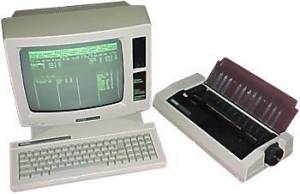This is an old revision of the document!
Table of Contents
AMSTRAD PCW 8256

Info
| Processor | Zilog Z80A at 4MHz with waiting cycles. |
|---|---|
| RAM memory | 256 KB expandable to 512 KB internally. 112Kb RAM disk. |
| ROM memory | It does not have boot ROM. |
| Chips | Gate Array designed by Amstrad, uPD765 disk controller. |
| Charts | Resolution of 720×256 pixels in graphic mode with text in 90×32 (90 columns x 32 lines) (monochrome). The screen is line-mapped anywhere in the initial 128 KB, storing the reference in 512 bytes called roller-RAM. |
| Sound | Fixed frequency generator. Internal speaker output (no volume control). |
| Connections | Expansion bus, and keyboard and printer connectors (specific to PCW). |
| Internal Support | 3“ floppy drive with 180 KB per side. A second 720 KB drive can be installed. |
| Monitor | Green phosphor that incorporates 2 3-inch bays on the right front. 13-inch screen |
| Keyboard | 82 plastic keys in QWERTY/QWERTZ/AZERTY format depending on the country. |
| Price | Spain: 169,900 pesetas. - USA: $499 - France: F6,990 |
Description
The Amstrad PCW 8256 is the first computer of the PCW series. It's powered by a 4 Mhz Z80 processor and has a screen resolution of 720 x 256 pixels.
This computer has a 3” 180 KB single side drive and 256 KB of RAM, expandable to 512 KB. A matrix printer with a custom interface is provided, as the computer has no standard serial or parallel ports.
The computer is supplied with the Locoscript word processor (developed for this machine), and the CP/M Plus operating system, both by Locomotive Software.
The Amstrad PCW was launch to get the small business market by offering a computer, a printer and a word processor cheaper than a typewriter. Even with a 3“ drive (when 3.5” drives were becoming the industry standard), it was a huge success. Amsoft converts many of its CP/M applications to that format, making it easier to find DBase II on 3“ disks rather than on the original 5.25” disks. Even Microsoft launched all its CP/M compilers on that format. Due to the expensive price of the disks, kits for connecting external 5.25“ drives or internal 5.25” and 3.5“ drives (some modding needed) started to appear on the market. Suddenly, software houses started to develop games for the PCW, showing that the GSX expansion could be used for more than diagrams and charts. The RS232/Parallel interfaces allow the use of standard printers (some programs allowed using HP Laser printers) and PCW users started to visit BBS sites. In the end, 20 MB and 40 MB hard disk drives were also marketed.
Schneider distributed PCW computers in Germany under the names Joyce and Joyce Plus.
The were marketed shortly in the USA along the PC 1640, but weren't successful at all due to mail order. Probably, the german and american motherboards are slightly different from the european ones.
In Spain, peripherals for the PCW were quite expensive, which made difficult to use standard printers. When PC prices lowered, offices shifted to PCs with ink jet printers. For some time there was a market for PCW to PC files conversion.
